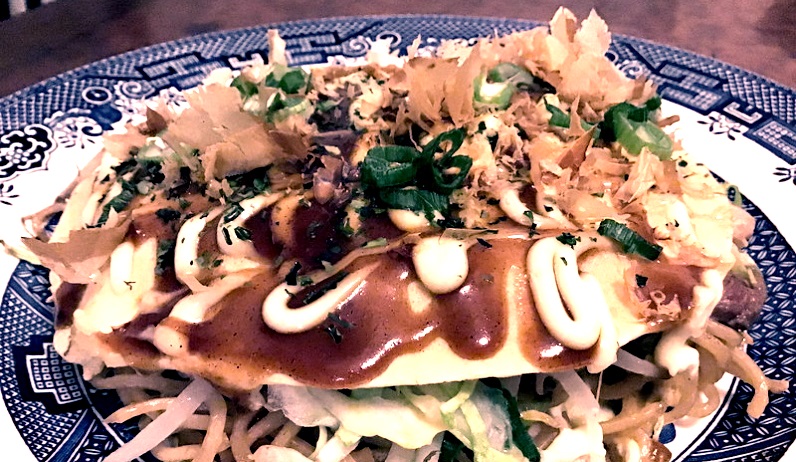
Okonomiyaki is sometimes referred to as "Japanese Pizza" or "Japanese Soulfood", this savory dish is a meal in itself and the blend of tastes is outstanding. This version is the Hiroshima style.
The word Okonomiyaki is derived from okonomi meaning "what you like" and yaki which means fried, grilled or baked. There are two major variations; The more widely found Osaki (or Kansai) Okonomiyaki which mixes many of the ingredients into the batter before it's cooked and the Hiroshima style Okonomiyaki which layers all the ingredients and adds a cooked egg and fried yakisoba noodles. Tokyo style Okonomiyaki is similar to the Osaka version, but the fritter is substantially smaller in diameter. Okonomiyaki is a relatively recent invention. Although there are possible precursors, Okonomiyaki made its first appearance in Osaka after WWII. In the war torn country food was very scarce so people had to make use of whatever they could find. Although rice is undoubtedly the most essential staple in Japan, after the war it was hard to find. Beyond the basic ingredients (batter, cabbage, sauce) you can add whatever you fancy although the recipe presented below is fairly standard. If you travel to Hiroshima and order Okonomiyaki, you will be served the Hiroshima style and although it is not as widely distributed as the Osaka version, there are nearly 2,000 okonomiyaki restaurants in Hiroshima. The dish used to be a street food, but now it is even more likely you will find it in a sit down restaurant. It is often found in festivals,usually the Osaka version which is easier to prepare. The following ingredients can be purchased in a Japanese or Asian grocery store.
Aonori (Seaweed flakes)
Okonomiyaki sauce
Pork belly (thinly sliced)
Tenkasu (Tempura bits)
Katsuobushi (Bonito flakes)
Japanese mayonaisse
Beni Shoga (pickled ginger)
Cook's notes: This dish uses thinly sliced pork belly which for all practical purposes is bacon that hasn't been cured, smoked or flavored. You can use bacon as a substitute but try to get a brand that is uncured and not overly flavored. We used a crepe making machine to make this dish, it worked superbly. Such machines are very inexpensive.
Ingredients:
- 1 cup all-purpose flour
- 1 cup water
- 1/2 teaspoon salt
- 4 eggs
- 1 pound of very thinly sliced cabbage
- 1 pound of bean sprouts
- 6 strips of thinly slice pork belly (substitute bacon - See note above)
- 2 packages of yaki soba noodles
- 2 green onions
- 1 2 teaspoons Aonori (fine Seaweed flakes)
- 1 cup Okonomiyaki sauce
- 2 tablespoons Tenkasu (Tempura bits)
- 4 tablespoons Katsuobushi (Shaved bonito flakes)
- Japanese mayonnaise
- Beni Shoga (red) or Kizami Beni Shoga (pink) pickled Ginger
Preparation:
- Whisk together the flower, salt, water, and 2 eggs in a bowl.
- Put 4 table spoons of the batter in a small bowl.
- Bring a medium sized pot of water to a boil.
- Parboil the yakisoba noodles for about 15 seconds, separating them with chopsticks or a fork.
- Drain the noodles and set aside.
- Lightly oil a large frying pan or crepe maker and heat the pan to medium before the next step.
- From the larger bowl of batter, pour 1/2 the batter into the frying pan. Using the back of a ladle spread the batter out into a evenly thick circle about 6 inches wide.
- Add half the cabbage and half the sprouts on top of the batter, try not to go outside of the pancake circle.
- Distribute half the Tenkasu and half of the white part of the scallions on top of the cabbage and sprouts.
- Festoon the top with 3 strips of pork belly.
- Distribute half the batter in the small bowl over the top.
- Cook for 7 to 10 minutes.
- While the Okonomiyaki is cooking, heat the yaki soba noodles mixing in 2 tablespoons of the Okonomiyaki sauce.
- Using two spatulas, flip the Okonomyaki and cook for an additional 7 to 10 minutes.
- Add half the noodles to the fry pan (or crepe maker) and create a 6 inch wide circle with them.
- Lift the Okonomiyaki and place on top of the noodles.
- Break 1 egg into the frying pan and break the yolk. Try to push the egg into a circle the width of the Okonomiyaki.
- Cook egg for 2 minutes.
- Lift the Okonomiyaki and place on top of egg.
- Carefully flip the Okonomiyaki over.
- In a criss-cross fashion add a generous amount of Okonomiyak sauce and Japanese mayonaisse.
- Sprinkle half the Katsuabushi and half the green part of the sliced scallions over the top.
Recipe and photo: T. Johnston-O'Neill







